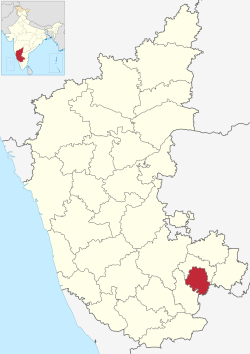
Back بنغالور منطقة الحضرية Arabic بنجالور الحضريه ARZ Distritu de Bangalore AST बंगलौर शहरी जिला Bihari বেঙ্গালুরু নগর জেলা Bengali/Bangla Districte de Bangalore Urbà Catalan Bangalore Urban CEB Bengaluru Urban German Distrito de Bangalore Spanish Bengaluru Urban barrutia Basque
Bangalore Urban district | |
|---|---|
| Bengaluru Urban district | |
Clockwise from top-left: Brigade Road at night, Dodda Basavana Gudi, Bangalore Palace, Skyline of Bangalore, Vidhana Soudha | |
 Location in Karnataka | |
| Coordinates: 12°58′13″N 77°33′37″E / 12.970214°N 77.56029°E | |
| Country | |
| State | Karnataka |
| Headquarters | Bangalore |
| Talukas[1] | Bangalore North, Bangalore South, Bangalore East, Yelahanka and Anekal |
| Government | |
| • Deputy Commissioner | Dayananda K A (IAS) |
| • Additional Deputy Commissioner | T. N. Krishnamurthy |
| Area | |
| • Total | 2,196 km2 (848 sq mi) |
| Population (2011)[2] | |
| • Total | 9,621,551 |
| • Rank | 3rd (India) |
| • Density | 4,400/km2 (11,000/sq mi) |
| Languages | |
| • Official | Kannada |
| Time zone | UTC+5:30 (IST) |
| Vehicle registration | Source[3]
|
| GDP (PPP)(2022-23) | $ 300 Billion[4] |
| Per Capita Income (PPP)(2022-23) | $ 25,461[5] |
| Nominal GDP (2022-23) | ₹8.59154 trillion (US$100 billion) [6] |
| Per Capita Income (Nominal)(2022-23 ) | ₹760,321 (US$9,100) [7] |
Bangalore Urban district is the most densely populated of the thirty-one districts that comprise the Indian state of Karnataka. It is surrounded by the Bangalore Rural district on the east and north, the Ramanagara district on the west and the Krishnagiri district of Tamil Nadu on the south. Bangalore Urban district came into being in 1986, with the partition of the erstwhile Bangalore district into Bangalore Urban and Bangalore Rural districts. Bangalore Urban has three taluks : Bangalore City, Yelahanka and Anekal. It has seventeen hoblies, 872 villages, eleven rural habitations, five towns, one tier-three city and one tier-one city, administered by ninety-six Village Panchayats (Grama Panchayitis), ninety-seven Taluk Panchayats (Taluk Panchayitis), five Town Municipal Councils (Purasabes), one City Municipal Council (Nagarasabe) and one City Corporation (Mahanagara Palike).
The district had a population of 6,537,124 of which 88.11% is urban as of 2001.[8] As of Census 2011, its population has increased to 9,621,551, with a sex-ratio of 908 females/males, the lowest in the state and its density is 4,378 people per square km.[9]
- ^ "About District - District Bengaluru Urban". Government of Karnataka, India. Retrieved 17 May 2024.
- ^ a b Bangalore District Population Census 2011, Karnataka literacy sex ratio and density
- ^ "Registering Authorities & Code No". Transport Department, Karnataka. Retrieved 30 April 2024.
- ^ "Deep Dive City Bangalore, India" (PDF). Transformative Urban Mobility Initiative. Retrieved 9 January 2024.
- ^ "Deep Dive City Bangalore, India" (PDF). Transformative Urban Mobility Initiative. Retrieved 9 January 2024.
- ^ |Karnataka Economic Survey 2023-24||https://des.karnataka.gov.in/storage/pdf-files/ARC/Economic_Survey_2023-24_FINALENGLISH.pdf%7C
- ^ |Karnataka Economic Survey 2023-24||https://des.karnataka.gov.in/storage/pdf-files/ARC/Economic_Survey_2023-24_FINALENGLISH.pdf%7C
- ^ Census GIS India Archived 24 May 2012 at archive.today
- ^ "Girls are still scarce in IT City". The Times of India. 6 April 2011. Archived from the original on 5 November 2012.




